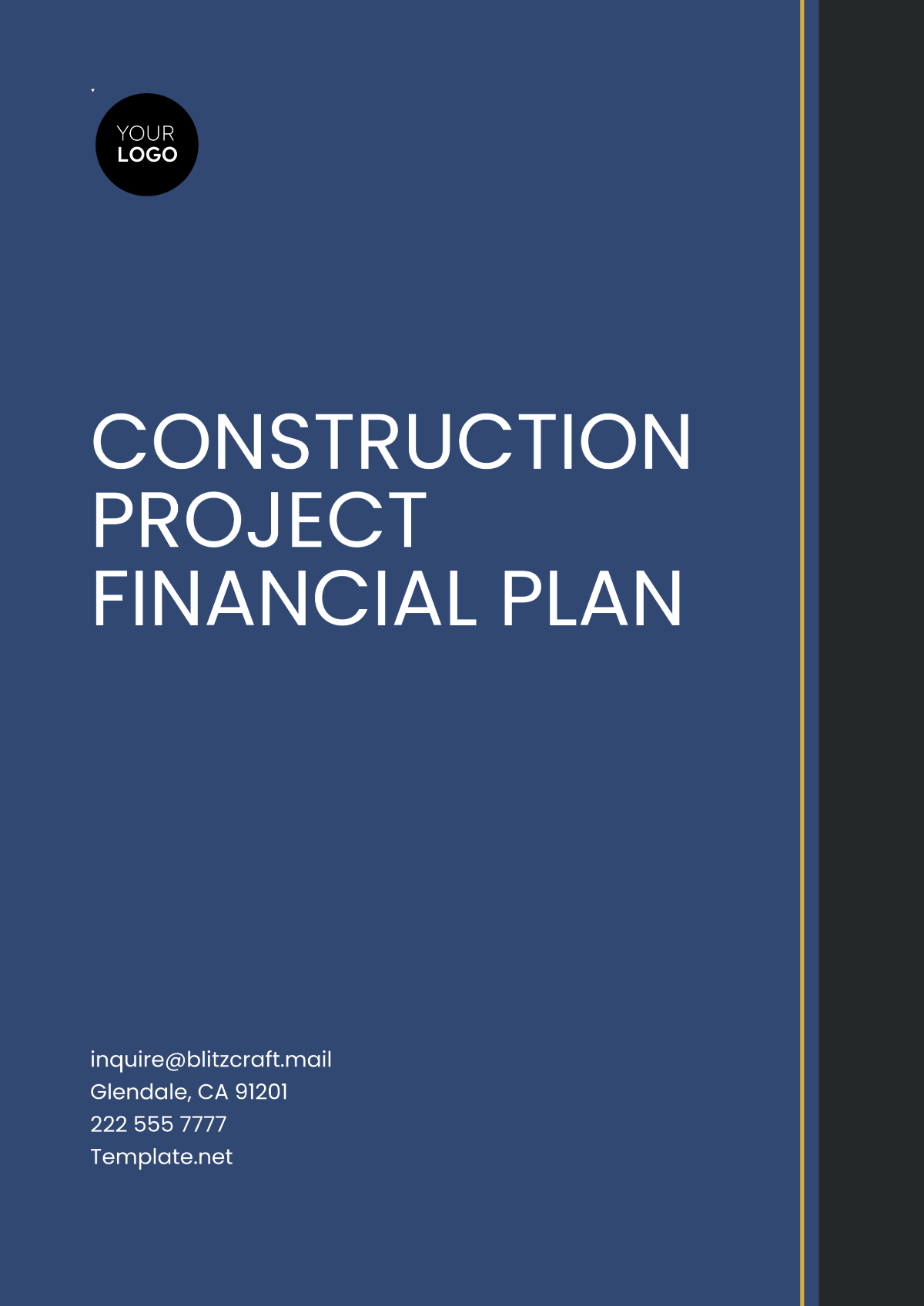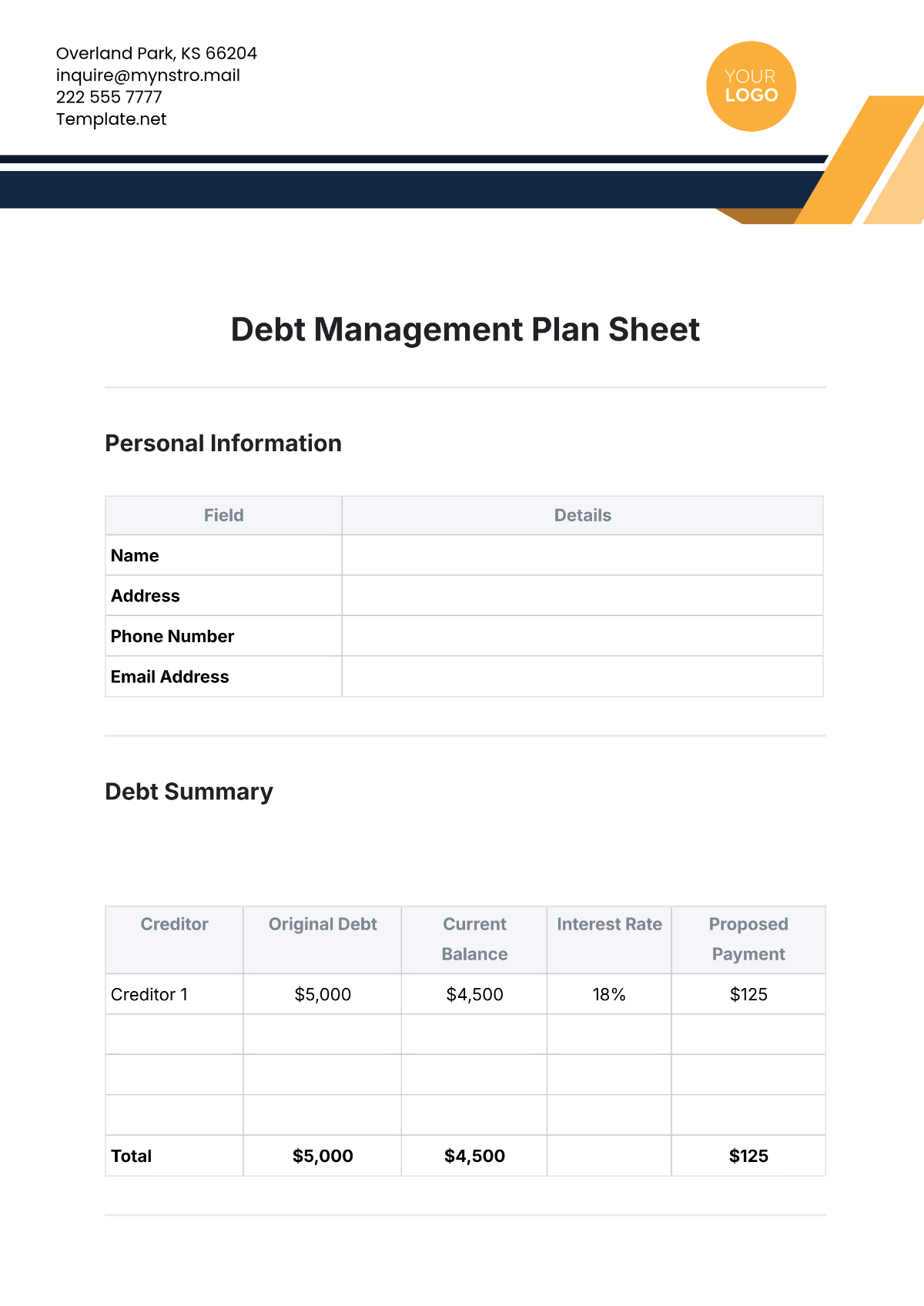Finance Portfolio Restructuring Plan
Executive Summary
Introduction
In an ever-evolving economic landscape, it is imperative for [Your Company Name] to periodically reassess and restructure its financial portfolio to stay ahead of the curve. The primary focus of this comprehensive Finance Portfolio Restructuring Plan is to strategically overhaul our current asset allocation, risk management, and investment approaches. The plan is meticulously designed to optimize the distribution of assets across various categories, thereby reducing vulnerabilities associated with market volatility and unforeseen economic shifts.
By adopting a more dynamic and diversified investment strategy, we aim to not only preserve but also enhance the overall financial health and performance of [Your Company Name]. This proactive approach ensures that the company's financial resources are allocated in a manner that aligns with both current market opportunities and our long-term vision for growth and stability.
Objective
The principal objective of this restructuring plan is to realign [Your Company Name]'s financial portfolio with its overarching strategic objectives, taking into consideration the latest market trends and economic forecasts. This realignment involves a thorough analysis of our current financial standing, followed by the implementation of tailored strategies to address identified gaps and opportunities.
By doing so, we aim to achieve a more balanced and resilient portfolio that not only withstands market fluctuations but also contributes positively to the company's profitability and long-term value creation.
Furthermore, this plan will also focus on enhancing our risk management protocols, ensuring that all investment decisions are well-calibrated to balance potential returns against associated risks.
The end goal is to foster a robust financial ecosystem within [Your Company Name] that supports sustainable growth, maximizes shareholder value, and solidifies our market position in the face of evolving economic conditions.
Initial Portfolio Analysis
The first phase of the portfolio restructuring plan involves a thorough analysis of the current portfolio. Here's a tabulated break down of the company's current financial portfolio:
Assets | Percentage of Portfolio | Return (%) |
|---|---|---|
Equities | 40% | 8% |
Bonds | 30% | 5% |
Real Estate | 20% | 6% |
Commodities | 10% | 4% |
Risk Profile Assessment
Evaluating the risk profile of our current portfolio is fundamental to our restructuring strategy. This assessment addresses the key risks associated with our investments, including market, credit, and liquidity risks. Understanding these risks aids in making strategic decisions to mitigate potential losses and capitalize on growth opportunities.
Market Risk: This risk is associated with fluctuations in the financial markets, affecting primarily Stocks and Other Investments. Market dynamics, economic changes, and geopolitical events can significantly impact these assets.
Credit Risk: This involves the risk of loss from a counter party's default. Bonds and certain Other Investments are subject to this risk. Assessing the creditworthiness of entities we are invested in is crucial for mitigating credit risk.
Liquidity Risk: Liquidity risk pertains to the ease of converting assets into cash. Real Estate, due to its nature, typically possesses higher liquidity risk compared to more liquid assets like Cash & Equivalents.
This comprehensive analysis of [Your Company Name]'s current portfolio, both in terms of asset distribution and risk assessment, provides a solid foundation for our forthcoming financial restructuring plan.
Optimal Portfolio Suggestion
This phase involves an optimized financial structure post-restructuring.
New Assets | Percentage of Portfolio | Expected Return (%) |
|---|---|---|
Equities | 35% | 8% |
Bonds | 40% | 5.5% |
Real Estate | 15% | 6.5% |
Commodities | 5% | 4.5% |
Emerging Technological Funds | 5% | 10% |
Restructuring Strategy
Asset Reallocation
As part of our financial restructuring, asset reallocation is a critical strategy for [Your Company Name]. This approach aims to balance the risk-reward ratio by adjusting the composition of our current portfolio. The focus is on two main aspects: reducing exposure to high-risk assets and diversifying investments into emerging markets or sectors.
Reducing High-Risk Asset Exposure: Our analysis indicates a need to decrease investments in volatile markets, particularly in certain stocks that have shown significant fluctuations. The goal is to mitigate potential losses from market downturns by reallocating funds from these high-risk assets into more stable investment options.
Diversification into Emerging Markets or Sectors: To enhance the growth potential of our portfolio, we plan to invest in emerging markets and innovative sectors. These areas offer opportunities for higher returns and can counterbalance the more traditional, low-risk investments. This diversification is not only geographical but also sectoral, including areas like technology, renewable energy, and healthcare.
Debt Management
Effective debt management is crucial for maintaining the financial health of [Your Company Name]. Our strategy focuses on two primary actions: refinancing high-interest debts and negotiating better terms for existing loans.
Refinancing High-Interest Debts: The current interest rates on some of our debts are significantly higher than market averages. We plan to refinance these debts, seeking lower interest rates and more favorable terms. This action will reduce our interest expenses and free up cash flows for other investments.
Negotiating Better Terms for Existing Loans: We will engage with our current creditors to renegotiate the terms of our existing loans. The objective is to secure lower interest rates, extended repayment periods, or more flexible payment structures. These negotiations will aim to ease the financial burden on the company and improve our debt servicing capacity.
Cash Flow Management
Effective cash flow management is essential for the operational and financial stability of [Your Company Name]. Our strategy includes enhancing receivables collection and optimizing payment terms with suppliers.
Improving Receivables Collection: We plan to implement stricter credit control measures and accelerate the collection process. This may involve revising our credit policies, using more efficient invoicing systems, and actively following up on overdue accounts. Improving our receivables turnover will increase our cash flow and reduce the need for external financing.
Optimizing Payment Terms with Suppliers: We will renegotiate terms with our suppliers to align payment schedules more closely with our revenue cycles. This includes seeking extended credit terms or discounts for early payments. Such measures will help in managing our outflows more effectively, maintaining a healthy cash balance to support day-to-day operations and strategic investments.
In conclusion, this three-pronged restructuring strategy – focusing on asset reallocation, debt management, and cash flow optimization – is designed to fortify the financial foundation of [Your Company Name], ensuring long-term sustainability and growth.
Implementation Plan
The success of the Finance Portfolio Restructuring Plan for [Your Company Name] hinges on a meticulously crafted and effectively executed implementation plan. This section outlines the specific actions required to bring our restructuring strategy to fruition. It delineates clear responsibilities, sets firm deadlines, and provides essential notes for each action item, ensuring a coordinated and efficient approach to portfolio restructuring. The plan is designed to be both pragmatic and flexible, allowing for adjustments as needed while keeping the overall strategic objectives in focus.
Action Item: This column lists the specific tasks that need to be executed as part of the restructuring process.
Responsible Party: Identifies the individual or team accountable for the completion of each action item.
Deadline: Indicates the target date for completing each task, ensuring timely progress and adherence to the overall timeline.
Notes: Provides additional information or specific focus areas for each action item, guiding the execution process.
Review Current Asset Allocation: This involves a comprehensive review of the existing asset distribution in the portfolio. [Your Name] will assess the performance and risk profile of each asset category, identifying areas for reallocation or divestment.
Negotiate Loan Terms: The Financial Manager is tasked with renegotiating the terms of existing loans. The goal is to secure more favorable terms, potentially reducing the financial strain on the company through lower interest rates or extended repayment periods.
Invest in [Specific Sector]: The Investment Team will explore opportunities in a specified sector, focusing on emerging markets that show promise of high growth and returns. This action aligns with our strategy to diversify the portfolio and capitalize on new market trends.
This implementation plan provides a clear roadmap for action, assigning specific responsibilities and deadlines to ensure that our restructuring objectives are met efficiently and effectively. The success of this plan is integral to achieving the desired financial stability and growth for [Your Company Name].
Monitoring and Adjustment
The Monitoring and Adjustment section is crucial in ensuring the ongoing success and viability of our investment strategies. This section outlines the processes and criteria for regular review and adjustment of the investment portfolio, focusing on maintaining alignment with our financial goals and adapting to market dynamics.
Regular Review
Quarterly Portfolio Reviews:
Frequency: Reviews are conducted every quarter to assess the performance of the investment portfolio.
Scope: These reviews encompass an analysis of asset allocation, risk exposure, and overall portfolio performance.
Outcome: Based on the review, recommendations will be made for any necessary adjustments.
Market and Company Performance-Based Adjustments
Market Analysis: Regular analysis of market trends and economic indicators to inform investment decisions.
Company Performance Tracking: Monitoring of individual company performance within the portfolio to identify any underperforming assets.
Responsive Actions: Timely adjustments will be made in response to significant market fluctuations or changes in individual company performance.
Performance Metrics
The performance of the investment portfolio will be evaluated based on the following key metrics:
Return on Investment (ROI)
Definition: ROI measures the gain or loss generated on an investment relative to the amount of money invested.
Calculation Method: ROI is calculated by dividing the net profit (or loss) of the investment by the initial cost of the investment.
Target: The target ROI will be set annually, reflecting our strategic financial goals.
Asset Growth Rate
Definition: This metric assesses the rate at which the portfolio’s total value is increasing over time.
Measurement: Calculated as the percentage increase in the portfolio's total value over a specified period.
Benchmarking: The growth rate will be benchmarked against industry standards and historical performance data to gauge effectiveness.
These monitoring and adjustment strategies are designed to optimize the portfolio's performance and ensure alignment with our long-term investment objectives. Regular and rigorous application of these procedures will enable us to respond effectively to changing market conditions and maintain a robust investment strategy.
Risk Management
The Risk Management section is a vital component of our overall strategy, aimed at identifying, assessing, and mitigating financial risks to ensure the stability and security of our investments. This section outlines our approach to contingency planning and adherence to compliance and regulations, thereby safeguarding our assets and ensuring our operations are within legal and ethical boundaries.
Contingency Planning
Effective contingency planning is essential for mitigating unforeseen risks and ensuring the resilience of our financial portfolio. Our approach includes:
Establishment of an Emergency Fund
Purpose: To provide a financial buffer in case of unexpected events or market downturns.
Funding: This fund will be capitalized with a percentage of annual profits and maintained at a level sufficient to cover short-term emergency needs.
Accessibility: The fund will be kept in a liquid state to ensure immediate availability when required.
Insurance Policies for Significant Assets
Coverage: Comprehensive insurance coverage will be secured for all significant assets within the portfolio.
Risk Assessment: Regular assessments will be conducted to determine the appropriate level and type of insurance needed based on the risk profile of each asset.
Policy Review: Insurance policies will be reviewed annually to ensure they remain adequate and relevant to the value and nature of the insured assets.
Compliance and Regulations
Adhering to financial regulations and ensuring compliance is paramount for maintaining the integrity and legality of our operations.
Adherence to Financial Regulations
Regulatory Framework: Ongoing monitoring of changes in financial regulations at local, national, and international levels.
Implementation: Incorporation of regulatory requirements into all business practices and investment decisions.
Training: Regular training for staff to remain informed and compliant with the latest financial regulations.
Regular Audits and Compliance Checks
Internal Audits: Conducting internal audits periodically to ensure compliance with internal policies and regulatory requirements.
External Audits: Engagement of external auditors for unbiased and comprehensive compliance verification.
Corrective Measures: Implementation of corrective actions promptly in case of any compliance issues identified during audits.
Through these risk management strategies, we aim to proactively address potential financial risks, ensuring the sustainable growth and stability of our investments. This comprehensive approach to risk management is integral to our commitment to responsible and effective financial stewardship.
Conclusion
This Finance Portfolio Restructuring Plan represents a comprehensive and strategic framework for [Your Company Name] to enhance and protect its financial interests. It encompasses a multi-faceted approach, including diversification and rebalancing of investments, leveraging advanced analytics for data-driven decision making, ensuring robust monitoring and adjustment mechanisms, and implementing a proactive risk management strategy. These elements are designed to align with our overarching financial objectives, adapting to market dynamics while prioritizing stability and growth.
The plan's implementation will require disciplined execution, ongoing evaluation, and the flexibility to adapt to changing financial landscapes. By adhering to the strategies outlined in this document, [Your Company Name] will be well-positioned to achieve a more resilient and dynamic financial portfolio, which is crucial for long-term success and sustainability.
Our commitment to these principles and practices demonstrates a proactive approach to financial management. This plan is not just a pathway to improved financial performance but also a testament to our dedication to fiscal responsibility and strategic foresight. [Your Company Name] is poised for a future of enhanced financial strength and stability, ensuring we remain competitive and capable of capitalizing on new opportunities as they arise. This plan is a crucial step in that journey, laying the groundwork for a prosperous and financially robust future.
For further information or inquiries, please contact:
[Your Name]
[Your Personal Email]
[Your User Phone]

















































